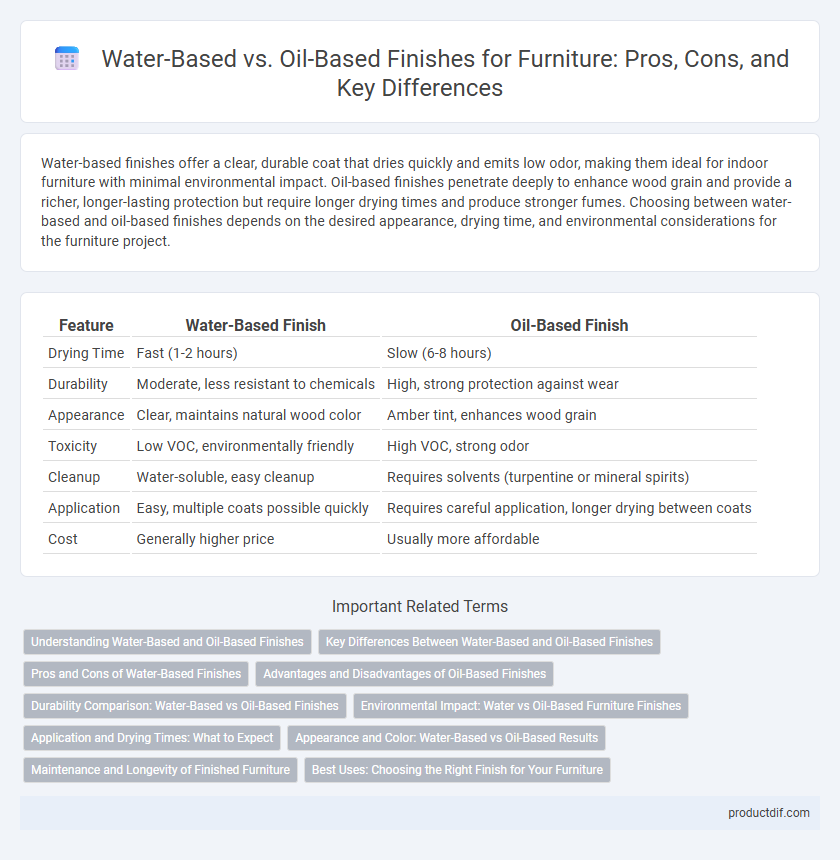Water-based finishes offer a clear, durable coat that dries quickly and emits low odor, making them ideal for indoor furniture with minimal environmental impact. Oil-based finishes penetrate deeply to enhance wood grain and provide a richer, longer-lasting protection but require longer drying times and produce stronger fumes. Choosing between water-based and oil-based finishes depends on the desired appearance, drying time, and environmental considerations for the furniture project.
Table of Comparison
| Feature | Water-Based Finish | Oil-Based Finish |
|---|---|---|
| Drying Time | Fast (1-2 hours) | Slow (6-8 hours) |
| Durability | Moderate, less resistant to chemicals | High, strong protection against wear |
| Appearance | Clear, maintains natural wood color | Amber tint, enhances wood grain |
| Toxicity | Low VOC, environmentally friendly | High VOC, strong odor |
| Cleanup | Water-soluble, easy cleanup | Requires solvents (turpentine or mineral spirits) |
| Application | Easy, multiple coats possible quickly | Requires careful application, longer drying between coats |
| Cost | Generally higher price | Usually more affordable |
Understanding Water-Based and Oil-Based Finishes
Water-based finishes offer quick drying times, low VOC emissions, and a clear, non-yellowing appearance ideal for preserving wood's natural color. Oil-based finishes provide a durable, long-lasting protective layer with rich amber tones that deepen wood grain and resist wear and moisture effectively. Choosing between water-based and oil-based finishes depends on desired aesthetics, environmental impact, and durability requirements for different furniture applications.
Key Differences Between Water-Based and Oil-Based Finishes
Water-based finishes dry faster and emit fewer volatile organic compounds (VOCs), making them more environmentally friendly and suitable for indoor use. Oil-based finishes provide a richer color depth and greater durability, often preferred for furniture subjected to heavy wear. The choice between these finishes depends on the desired appearance, drying time, and exposure to moisture or wear.
Pros and Cons of Water-Based Finishes
Water-based finishes offer fast drying times and low odor, making them ideal for indoor furniture projects requiring quick use and minimal fumes. They provide excellent clarity and UV resistance, preserving the natural color of wood without yellowing over time. However, water-based finishes may raise the wood grain, requiring extra sanding, and typically offer less durability and abrasion resistance compared to oil-based alternatives.
Advantages and Disadvantages of Oil-Based Finishes
Oil-based finishes provide a durable and hard protective layer that enhances the natural grain of wood, making it ideal for high-traffic furniture pieces. These finishes resist scratches and heat better than water-based alternatives but tend to yellow over time and require longer drying periods. The strong odor and higher VOC emissions during application pose environmental and health considerations compared to water-based finishes.
Durability Comparison: Water-Based vs Oil-Based Finishes
Water-based finishes offer moderate durability with fast drying times and resistance to yellowing, making them ideal for indoor furniture exposed to light use. Oil-based finishes provide superior durability against scratches, heat, and moisture, offering a harder protective layer suitable for high-traffic or outdoor furniture. Long-term maintenance of oil-based finishes often involves less frequent reapplication compared to water-based alternatives, which may wear down more quickly in heavy-use environments.
Environmental Impact: Water vs Oil-Based Furniture Finishes
Water-based furniture finishes release fewer volatile organic compounds (VOCs), reducing air pollution and health risks compared to oil-based finishes, which emit higher VOC levels and contribute to smog formation. Water-based finishes are typically biodegradable and have lower toxicity, making them more environmentally sustainable during production and disposal phases. Oil-based finishes, derived from petroleum, have a larger carbon footprint due to extraction processes and slower biodegradability, increasing soil and water contamination risks.
Application and Drying Times: What to Expect
Water-based finishes offer faster drying times, typically becoming touch-dry within 1 to 2 hours and fully curing in 24 hours, making them ideal for quick project turnaround. Oil-based finishes require significantly longer drying and curing periods, often taking 6 to 8 hours to dry to the touch and up to 7 days for full hardness, which can extend the overall project timeline. Application of water-based finishes is generally easier with less odor and cleanup involving just soap and water, while oil-based finishes demand mineral spirits for application and cleanup, impacting work environment and timing.
Appearance and Color: Water-Based vs Oil-Based Results
Water-based finishes produce a clear, non-yellowing appearance that preserves the natural color and grain of the wood, making them ideal for light or vibrant woods. Oil-based finishes impart a warm, amber tone that enhances wood's richness but can darken and yellow over time, particularly on lighter species. Choosing between water-based and oil-based impacts color stability and the final aesthetic, with water-based offering a more transparent, true-to-wood finish while oil-based provides a deeper, aged look.
Maintenance and Longevity of Finished Furniture
Water-based finishes offer easier maintenance with quick drying times and resistance to yellowing, making them ideal for furniture exposed to sunlight. Oil-based finishes provide longer-lasting protection, enhancing the wood's natural grain and durability, but require more frequent upkeep due to slower drying and potential yellowing over time. Choosing between the two depends on the desired balance of longevity and ease of maintenance for specific furniture pieces.
Best Uses: Choosing the Right Finish for Your Furniture
Water-based finishes are ideal for furniture requiring a clear, non-yellowing coat that dries quickly and is low in odor, making them perfect for indoor pieces like children's furniture or modern designs. Oil-based finishes offer superior durability and depth of color, best suited for high-traffic furniture such as dining tables and antique restorations where a rich, warm patina is desired. Selecting between water-based and oil-based finishes depends on the desired aesthetic, environmental factors, and the level of maintenance expected for the furniture piece.
Water-based finish vs Oil-based finish Infographic

 productdif.com
productdif.com